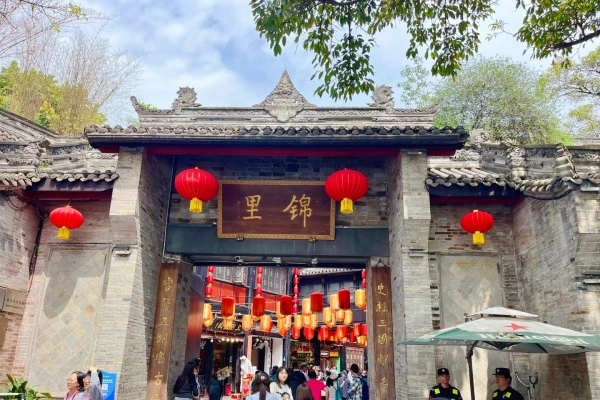Jinli Ancient Street
Historical Background
Jinli’s roots trace back to the Qin Dynasty (221–206 BCE), when it served as a bustling commercial corridor. Its name, meaning “Craftsman’s Alley,” reflects its legacy as a center for artisans and merchants. During the Three Kingdoms period (220–280 CE), it thrived under the patronage of Liu Bei, the first emperor of Shu Han. Rebuilt in 2004 to preserve its cultural identity, Jinli now blends historical reenactments with modern tourism, hosting annual festivals like the Lantern Fair and Temple Bazaar.
Architectural Style
Jinli’s architecture mirrors the traditional Qing Dynasty style, featuring curved eaves, carved wooden beams, and stone-paved pathways. Red lanterns adorn every corner, while courtyard homes and teahouses evoke a sense of old-world charm. Notable structures include the Sanxingdui Cultural Exhibition Hall and the Shu Kingdom History Museum, which display artifacts like bronze masks and pottery from the ancient civilization.

Culinary Delights
A food lover’s paradise, Jinli teems with stalls selling iconic Sichuan snacks. Sample dan dan mian (spicy noodles), long chaoshou (dragon-shaped wontons), and sugar-coated haws. For dessert, try three-gun sticky rice or rose ice cream. Many eateries offer outdoor seating, allowing visitors to savor flavors while watching street performances.
Handicrafts and Artistry
Jinli is a haven for traditional crafts. Artisans demonstrate skills like face-changing (a Sichuan Opera technique), sugar painting, and bamboo weaving. Shop for souvenirs like Shu embroidery, lacquerware, and Tibetan silver jewelry. The street’s workshops also offer hands-on experiences, such as calligraphy classes and clay figurine making.
Cultural Performances
Daily performances bring Jinli’s history to life. Sichuan Opera shows feature acrobatics, puppetry, and the iconic bian lian (face-changing) act. Tea ceremonies in courtyard teahouses pair traditional music with the aroma of jasmine tea. Evening light shows and fire-dragon dances add a magical touch after sunset.
Accommodation and Nearby Attractions
While Jinli itself lacks hotels, nearby Wuhouci District offers boutique guesthouses and luxury resorts. Combine your visit with the Wuhou Memorial Temple (dedicated to Zhuge Liang) or the Jinsha Site Museum (home to Sun God gold foil artifacts). The adjacent Kuanzhai Alley provides another glimpse into Chengdu’s historic lanes.
Travel Tips
Best Time to Visit: Early morning or late afternoon to avoid crowds.
Tickets: Free entry; performances and workshops may require fees.
Transport: Take subway Line 3 to Gaoshengqiao Station (Exit D) or Line 2 to Chunxi Road Station (Exit E).
Essentials: Carry cash for street vendors; wear comfortable shoes for cobblestone paths.
Respect Local Customs: Bargain politely in markets and avoid touching cultural artifacts.

